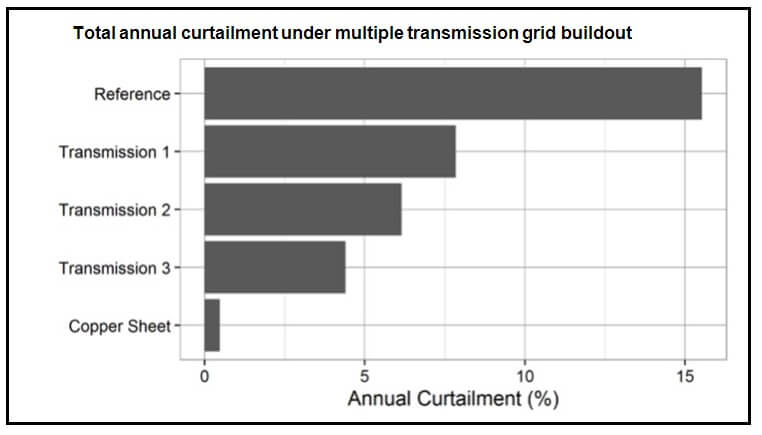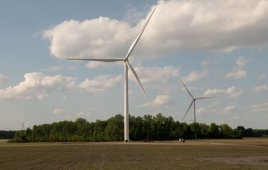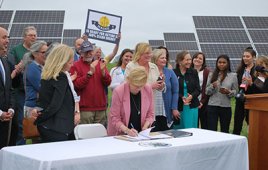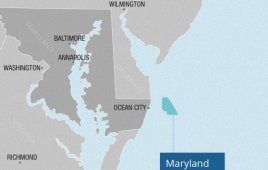Anna Flavia Rochas / NREL
New transmission capacity in Western U.S. could reduce total power generation costs by billions of dollars by reducing wind power curtailment and fossil fuel expenses said National Renewable Energy Laboratory aid in a study published in January.

The Plains & Eastern HVDC line will also impose a narrower right-of-way footprint than equivalent AC lines with the same transmission capacity, according to project files.
“To overcome the chicken-and-egg conundrum around transmission and deployment of remote renewable energy, coordinated generation and transmission planning, which isn’t the practice in many regions today, is really critical,” NREL researcher Jennie Jorgenson told Wind Energy Update.
Utilities in the Mid-South and Southeast U.S. are currently importing wind energy across a series of lower voltage alternating current lines, and congestion can cause curtailment of wind farms.
HVDC is proven to be the most efficient technology to reliably deliver large volumes of power, over such long distances, according to Patrick Plas, general manager of HVDC at GE, which will supply the three converter stations for the line.
The Plains & Eastern HVDC line will also impose a narrower right-of-way footprint than equivalent AC lines with the same transmission capacity, according to project files.
The project includes a converter station in Oklahoma that will be the link for most of the power plants and two additional converter stations in Arkansas and Tennessee.
New power plants would need to be connected close to converter stations, Plats said.
“There is a limitation in the HVDC technology, which is you cannot connect power plants just anywhere,” he said.
Clean Line Energy Partners has spent almost a decade developing the Plains & Eastern project and invested more than $100 million.
“The magnitude of the project requires leadership and persistence. Our hope is that success will beget success in building interstate transmission lines, Copple said.
“We are pleased with President Trump’s willingness thus far to support infrastructure projects, and we hope he will continue to use the bully pulpit [agenda platform] to move infrastructure projects along,” she said.
The U.S. would need to build 33,000 circuit miles of new transmission lines at a cost of $60 billion to support the aggressive wind growth strategy of 35% wind power penetration by 2050 set out in the Department of Energy’s 2015 Wind Vision Study.
NREL recently analyzed this scenario and found that curtailment of wind power generation could be reduced by around half to 7.8% by building four proposed transmission lines of combined capacity 10.5 GW.
These projects could reduce generation costs by $2.3 billion, NREL said in its study ‘Reducing Wind Curtailment through Transmission Expansion in a Wind Vision Future.’
The first transmission line would see the greatest reduction in curtailment and “further transmission buildout continues to reduce curtailment and generation costs but with diminishing returns,” NREL said.

The bar chart present annual curtailment, in terms of % of renewable energy available but unused, and reduces with increasing transmission expansion. The Reference represents the scenario with no transmission beyond what is currently planned. Transmission 1, 2, and 3 represent scenarios with increasing amounts of transmission builds. Copper Sheet is a bounding scenario with unlimited transmission capacity between nodes.
Source: NREL study ‘Reducing Wind Curtailment through Transmission Expansion in a Wind Vision Future.’ (January 2017)
NREL also warned that transmission must provide flexibility by implementing efficient scheduling practices such as fixed bilateral contracts, to minimize the risk of curtailment. The laboratory is now conducting two further studies on transmission expansion, Jorgenson told Wind Energy Update.
The Interconnection Seams Study is investigating opportunities to integrate the East and West grids by strengthening connections between these regions and using energy generation resources more efficiently.
A second study, which is the largest integration study NREL has undertaken, will evaluate the further interconnection of Canada, U.S. and Mexico power systems.
“Both of these studies will provide insight as to how upgrading our transmission grid infrastructure can provide increased affordability, sustainability, reliability, and resiliency,” Jorgenson said.
NREL expects to complete the Interconnection Seams Study by the end of this year and plans to produce a final report on the Canada-U.S.-Mexico grid study by 2018-2019. Initial findings may be released in the interim, Jorgenson said.
Filed Under: Uncategorized




